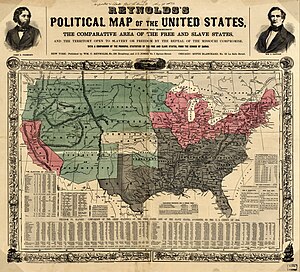Bloody Kansas
| Bleeding Kansas | |||||||
|---|---|---|---|---|---|---|---|
| Part of the prelude to the American Civil War | |||||||
 1856 map showing the slave states (gray), free states (pink), U.S. territories (green), and Kansas in center (white) |
|||||||
|
|||||||
| Belligerents | |||||||
|
John Brown others |
William Quantrill others |
||||||
| Casualties and losses | |||||||
| unknown, 100 or fewer (30–40 killed) | unknown, 80 or fewer (20–30 killed) | ||||||
Bleeding Kansas, Bloody Kansas or the Border War was a series of violent political confrontations in the United States involving anti-slavery "Free-Staters" and pro-slavery "Border Ruffian", or "southern" elements in Kansas. This military conflict happened between 1854 and 1861, including "Bleeding Congress". The Kansas–Nebraska Act of 1854 called for "popular sovereignty"—that is, the decision about slavery was to be made by the settlers (rather than outsiders). It would be decided by votes—or more exactly which side had more votes counted by officials. At the heart of the conflict was the question of whether Kansas would allow or outlaw slavery, and thus enter the Union as a slave state or a free state. Pro-slavery forces said every settler had the right to bring his own property, including slaves, into the territory. Anti-slavery "free soil" forces said the rich slaveholders would buy up all the good farmland and work it with black slaves, leaving little or no opportunity for non-slaveholders. As such, Bleeding Kansas was a conflict between anti-slavery forces in the North and pro-slavery forces from the South over the issue of slavery in the United States. The term "Bleeding Kansas" was coined by Republican Horace Greeley, editor of the New York Tribune; its violence indicated that compromise was unlikely, and thus it presaged the Civil War.
Through the Missouri Compromise of 1820, Congress kept a tenuous balance of political power between North and South. In May 1854, the Kansas–Nebraska Act created from unorganized Indian lands and territories of Kansas and Nebraska permitted residency by U.S. citizens, who were to determine their state's slavery status and seek admission to the Union. Immigrants supporting both sides of the question arrived in Kansas to establish residency and gain the right to vote. However, Kansas Territory officials were appointed (1854) by the pro-slavery administration of President Franklin Pierce (in office 1853–1857), and thousands of non-resident pro-slavery Missourians entered Kansas with the goal of winning elections. They captured territorial elections, sometimes by fraud and intimidation. In response, Northern abolitionist elements flooded Kansas with "free-soilers." Anti-slavery Kansas residents wrote the first Kansas Constitution (1855) and elected the Free State legislature in Topeka; this stood in opposition to the pro-slavery government in Lecompton. The two Territorial governments increased as well as symbolized the strife of Bleeding Kansas.
...
Wikipedia
